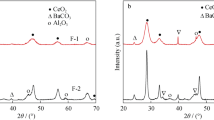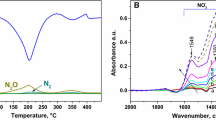Abstract
This study provides insight into the mechanistic and performance features of the cyclic reduction of NOx by CO in the presence and absence of excess water on a Pt–Rh/Ba/Al2O3 NOx storage and reduction catalyst. At low temperatures (150–200 °C), CO is ineffective in reducing NOx due to self-inhibition while at temperatures exceeding 200 °C, CO effectively reduces NOx to main product N2 (selectivity >70 %) and byproduct N2O. The addition of H2O at these temperatures has a significant promoting effect on NOx conversion while leading to a slight drop in the CO conversion, indicating a more efficient and selective lean reduction process. The appearance of NH3 as a product is attributed either to isocyanate (NCO) hydrolysis and/or reduction of NOx by H2 formed by the water gas shift chemistry. After the switch from the rich to lean phase, second maxima are observed in the N2O and CO2 concentrations versus time, in addition to the maxima observed during the rich phase. These and other product evolution trends provide evidence for the involvement of NCOs as important intermediates, formed during the CO reduction of NO on the precious metal components, followed by their spillover to the storage component. The reversible storage of the NCOs on the Al2O3 and BaO and their reactivity appears to be an important pathway during cyclic operation on Pt–Rh/Ba/Al2O3 catalyst. In the absence of water the NCOs are not completely reacted away during the rich phase, which leads to their reaction with NO and O2 upon switching to the subsequent lean phase, as evidenced by the evolution of N2, N2O and CO2. In contrast, negligible product evolution is observed during the lean phase in the presence of water. This is consistent with a rapid hydrolysis of NCOs to NH3, which results in a deeper regeneration of the catalyst due in part to the reaction of the NH3 with stored NOx. The data reveal more efficient utilization of CO for reducing NOx in the presence of water which further underscores the NCO mechanism. Phenomenological pathways based on the data are proposed that describes the cyclic reduction of NOx by CO under dry and wet conditions.











Similar content being viewed by others
References
Ozkan US, Cai YP, Kumthekar MW, Zhang LP (1993) J Catal 142:182–197
Ozkan US, Cai YP, Kumthekar MW (1994) J Catal 149:390–403
Takahashi N, Shinjoh H, Lijima T, Suzuki T, Yamazaki K, Yokota K (1996) Catal Today 27:63–69
Epling WS, Campbell LE, Yezerets A, Currier NW, Parks JE (2004) Catal Rev Sci Eng 46:163–245
Hodjati S, Petit C, Pitchon V, Kiennemann A (2000) Appl Catal B 27:117–126
Schmitz PJ, Baird RJ (2002) J Phys Chem B 106:4172–4180
Cant NW, Patterson MJ (2002) Catal Today 73:271–278
Fridell E, Skoglundh M, Westerberg B, Johansson S, Smedler G (1999) J Catal 183:196–209
Nova I, Castoldi L, Lietti L, Tronconi E, Forzatti P, Prinetto F (2004) J Catal 222:377–388
Nova I, Lietti L, Castoldi L, Tronconi E, Forzatti P (2006) J Catal 239:244–254
Lietti L, Nova I, Forzatti P (2008) J Catal 257:270–282
Nova I, Lietti L, Forzatti P (2008) Catal Today 136:128–135
Cumaranatunge L, Mulla SS, Yezerets A, Currier NW, Delgass WN, Ribeiro FH (2007) J Catal 246:29–34
Harold MP (2012) Curr Opin Chem Eng 1:303–311
Mulla SS, Chaugule SS, Yezerets A, Currier NW, Delgass WN, Ribeiro FH (2008) Catal Today 136:136–145
Poulston S, Rajaram RR (2003) Catal Today 81:603–610
Liu ZQ, Anderson JA (2004) J Catal 228:243–253
Abdulhamid H, Fridell E, Skoglundh M (2004) Top Catal 30(1):161–168
Dasari PR, Muncrief R, Harold MP (2012) Catal Today 184:43–53
Unland ML (1973) J Phys Chem 77:1952–1956
Rasko J, Solymosi F (1980) J Chem Soc Farad Trans I(76):2383–2395
Rasko J, Solymosi F (1981) J Catal 71:219–222
Solymosi F, Sarkany J, Schauer A (1977) J Catal 46:297–307
Solymosi F, Volgyesi L, Sarkany J (1978) J Catal 54:336–344
Solymosi F, Rasko J (1980) J Catal 63:217–225
Hecker WC, Bell AT (1984) Appl Catal 85:389–397
Kameoka S, Chafik T, Ukisu Y, Miyadera T (1998) Catal Lett 55:211–215
Ukisu Y, Miyadera T, Abe A, Yoshida K (1996) Catal Lett 39:265–267
Solymosi F, Rasko J (1980) J Catal 10:19–25
Miners JH, Bradshaw AM, Gardner P (1999) Phys Chem Chem Phys 1:4909–4912
Forzatti P, Lietti L, Nova I, Morandi S, Prinetto F, Ghiotti G (2010) J Catal 274:163–175
Nova I, Forzatti P, Prinetto F, Ghiotti G (2010) Catal Today 151:330–337
Unland ML (1973) Science 179:567–569
Szailer T, Kwak JH, Kim DH, Hanson JC, Peden CHF, Szanyi J (2006) J Catal 239:51–64
Lesage T, Verrier C, Bazin P, Saussey J, Daturi M (2003) Phys Chem Chem Phy 5:4435–4440
Bion N, Saussey J, Haneda M, Daturi M (2003) J Catal 217:47–58
Scholz CML, Maes BHW, De Croon M, Schouten JC (2007) Appl Catal A 332:1–7
Chansai S, Burch R, Hardacre C, Breen J, Meunier F (2010) J Catal 276:49–55
Chansai S, Burch R, Hardacre C, Breen J, Meunier F (2011) J Catal 281:98–105
Nova I, Lietti L, Forzatti P, Frola F, Prinetto F, Ghiotti G (2009) Top Catal 52:1757–1761
Castoldi L, Lietti L, Forzatti P, Morandi S, Ghiotti G, Vindigni F (2010) J Catal 276:335–350
Castoldi L, Lietti L, Bonzi R, Artioli N, Forzatti P, Morandi S (2011) J Phys Chem C 115:1277–1286
Morandi S, Ghiotti G, Castoldi L, Lietti L, Nova I, Forzatti P (2011) Catal Today 176:399–403
Unland ML (1973) J Catal 31:459–465
Kabin KS, Khanna P, Muncrief RL, Medhekar V, Harold MP (2006) Catal Today 114:72–85
Muncrief RL, Khanna P, Kabin KS, Harold MP (2004) Catal Today 98:393–402
Toops TJ, Smith DB, Epling WS, Parks JE, Partridge WP (2005) Appl Catal B 58:255–264
Chen Y, Wang HF, Burch R, Hardacre C, Hu P (2011) Faraday Disc 152:121–133
Clayton RD, Harold MP, Balakotaiah V (2009) AIChE J 55:687–700
Yongjie R, Harold MP (2011) ACS Catal 1:969–988
Theis J, Ura J, McCabe RW (2007) SAE Trans 2007-01-1055
Gandhi HS, Graham GW, McCabe RW (2003) J Catal 216:433–442
Acknowledgments
This research was supported by grants from the Texas Commission on Environmental Quality (TCEQ) and the Department of Energy Office of Vehicle Technologies (DE-EE0000205). We also acknowledge the catalyst division of BASF (Iselin, NJ) for providing the catalysts used in this study.
Author information
Authors and Affiliations
Corresponding author
Rights and permissions
About this article
Cite this article
Dasari, P., Muncrief, R. & Harold, M.P. Cyclic Lean Reduction of NO by CO in Excess H2O on Pt–Rh/Ba/Al2O3: Elucidating Mechanistic Features and Catalyst Performance. Top Catal 56, 1922–1936 (2013). https://doi.org/10.1007/s11244-013-0129-8
Published:
Issue Date:
DOI: https://doi.org/10.1007/s11244-013-0129-8




